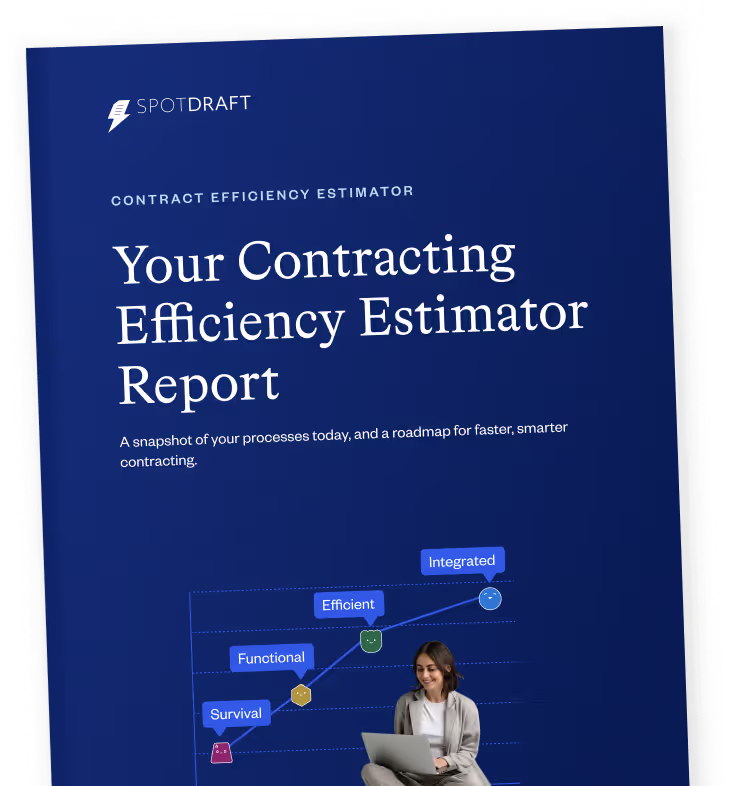TL;DR:
- Legal spend management means overseeing and controlling legal expenses to ensure efficiency and value
- Components: Centralized tracking, automated guideline enforcement, budgeting, and analytics.
- Benefits: Cost control, enhanced efficiency, better vendor relationships, and informed decision-making.
- Implementation steps: Set clear objectives, collaborate with service providers, leverage technology, and continuously evaluate performance
If you're handling legal expenses in your company, you’ve probably at least once opened an invoice from your outside counsel and thought, "Wait, we spent how much?" Managing your legal spend often feels messy and unclear, especially when bills pile up, budgets slip, and suddenly you're explaining to Finance why legal went over budget—again. But managing legal spend doesn’t have to be this stressful.
A solid legal spend management plan can help you track every dollar clearly, cut unnecessary costs, and free up your team from endless paperwork. It lets you work smarter with your vendors, spot overspending early, and confidently make better decisions about your legal budget.
In this article, we'll show you exactly how a structured legal spend management program can save your organization money, time, and headaches
What is legal spend management?
Legal spend management involves overseeing and controlling your organization's legal expenditures to ensure that every penny spent aligns with your company's goals and delivers value.
At its core, it’s about one thing: spending with intention.
4 Components of legal spend management

Legal spend management means knowing where the money goes for the corporate legal team and why.
Here’s what that actually looks like in practice.
#1 Centralized spend tracking
You can’t analyze what’s scattered.
Every invoice, matter, and accrual should live in one system. Not in email threads. Not across seven spreadsheets. Centralization gives you a baseline—what you’re spending, who’s billing you, and how fast it’s adding up.
#2 Enforced billing guidelines
If you’re not enforcing billing guidelines, you’re not managing spend. You’re just hoping vendors behave.
Clear rules are a start. But automated enforcement is where things change. Tools should flag timekeepers who shouldn’t be billing, reject disallowed costs, and highlight deviations the second they happen.
That’s how you stay ahead of overbilling, without turning invoice review into a full-time job.
#3 Layered budgeting
Department-wide budgets give you the big picture. Matter-level budgets catch the exceptions.
You need both.
When legal budgets are layered, you see where the overages are coming from. A litigation matter that goes nuclear won’t take your whole forecast with it.
Also read: Crafting the Best Legal Budget: Essential Strategies for Success
#4 Spend analytics
Spend management without analytics is just bookkeeping.
You need visibility into patterns: Which firms are consistently over budget? Which types of work cost the most? Are your vendors charging more than industry benchmarks?
Good analytics help you avoid repeating your mistakes.
4 Features of a legal spend management program

An effective legal spend management program is a necessity for any in-house legal team aiming to balance quality and cost. Here are the key features to look for:
#1 Real-time budget tracking
Keeping tabs on your legal expenses as they occur allows for immediate adjustments, ensuring that your financial resources are allocated effectively. This approach helps prevent budget overruns, enhances financial control, and drives cost savings.
#2 Vendor performance metrics
Evaluating your legal service providers based on efficiency, outcomes, and alignment with your business objectives ensures you're getting value for your money. Implementing performance metrics fosters better vendor relationships and promotes accountability.
#3 Compliance monitoring
Ensuring that all legal activities and expenditures comply with internal policies and external regulations reduces risk and promotes accountability. A robust compliance monitoring system helps maintain the integrity of your legal operations.
#4 Integration with financial systems
Seamlessly connecting your legal spend management tools with your organization's financial systems streamlines operations and ensures accurate financial reporting. This integration facilitates better financial planning and analysis.
Implementing these features can lead to improved cost control, enhanced efficiency, and better vendor relationships within your legal department.
4 Benefits of a legal spend management program
Managing your company's legal budget without clear visibility and control can lead to overspending, inefficient processes, and friction with legal service providers.
Implementing a structured legal spend management program solves these issues by providing transparency, efficiency, and actionable data.
#1 Cost control
Imagine having a finance director that's always on the ball, monitoring every penny spent and cutting costs where possible. That's what a legal spend management program does for you. It gives you the reins to control your legal expenses, ensuring you stay within budget.
Heineken, the global brewing company, adopted the legal sourcing platform Persuit to manage its legal expenditures. Since its implementation, Heineken has reported saving up to 75% on certain legal matters.
#2 Enhanced efficiency
Remember the old days of manual invoice processing? Legal spend management software throws that out the window. It automates mundane tasks like invoice review and spend reporting.
If Dropbox could eliminate 12 weeks’ worth of invoicing admin time in the first year using Brightflag’s legal spend management tool, you could too!
#3 Improved vendor relationships
A strong relationship with your legal vendors is essential. Legal spend management ensures clear communication of expectations and performance. This transparency builds trust and fosters long-term partnerships.
Organon, a healthcare company, utilized Priori's outside counsel management tool to create an easy-to-use scorecard for rating its law firms. This system facilitated better feedback to law firms, resulting in more appropriate and timely responses, thereby enhancing vendor relationships.
#4 Informed decision-making
Having data at your fingertips can transform the way you handle legal operations. Legal spend management tools provide detailed analytics and reports, empowering you to make smarter, data-driven decisions.
Access to detailed analytics and reports empowers you to make strategic decisions regarding legal matters and resource allocation.
Implementing legal spend management empowers your organization with more efficient, transparent, and strategic legal operations.
How to implement a legal spend management program
Legal Spend Management Implementation Checklist:
- Audit current legal expenses and identify areas for improvement
- Define clear objectives (cost reduction, efficiency, compliance)
- Set measurable KPIs for tracking progress
- Document clear billing guidelines for external legal providers
- Regularly communicate and negotiate with external counsel
- Evaluate and select legal spend management software
- Ensure software integration with existing financial systems
- Automate routine tasks (invoice review, reporting, spend tracking)
- Schedule regular performance reviews (monthly/quarterly)
- Analyze data and adjust strategies accordingly
Implementing a legal spend management program doesn't have to be overwhelming. Here's a clear, actionable roadmap to help you get started:
#1 Establish clear objectives and benchmarks
Before anything else, pinpoint exactly what you want to achieve with your legal spend management program. Common objectives include:
- Reducing overall legal expenses
- Improving operational efficiency
- Enhancing compliance and transparency
Then, follow these steps:
- Conduct an internal audit of your current legal spend. Identify your baseline costs and set realistic targets (e.g., reduce annual spend by 20% within 12 months)
- Clearly document your objectives and communicate them across your team to ensure alignment
- Define measurable KPIs (e.g., average invoice processing time, percentage reduction in legal spend, or vendor compliance rate).
#2 Collaborate with legal service providers
Strong partnerships with outside counsel can significantly improve your spend management outcomes.
- Schedule regular meetings with your legal providers to clarify billing practices and expectations
- Negotiate billing terms clearly, considering alternative fee arrangements such as fixed fees, capped fees, or blended rates
- Create clear billing guidelines and share them with vendors. This should cover invoice submission standards, preferred billing formats, and rules around unauthorized expenses
- Set up a vendor scorecard or evaluation system that objectively tracks vendor performance against your defined criteria
#3 Leverage technology
Investing in specialized legal spend management software can dramatically streamline your processes.
- Look for software features that match your objectives:
- Automated invoice review and approval workflows
- Real-time spend tracking dashboards
- Budget forecasting and alerts for potential overspending
- Robust reporting and analytics for actionable insights
- Shortlist software solutions based on your needs. Top providers include Brightflag, SimpleLegal, and Onit.
- Request demos and trials before committing. Involve key stakeholders from your finance and legal teams during these trials
- Ensure the selected software integrates seamlessly with your existing accounting, ERP, or financial systems
Also read: When to Buy a CLM and Secure Budget
#4 Monitor and evaluate performance
Continuous evaluation is crucial for sustained success.
- Schedule monthly or quarterly reviews of your legal spend data and vendor performance
- Analyze your performance against initial benchmarks and adjust goals if necessary
- Identify trends or recurring issues, and address these proactively with corrective actions (e.g., renegotiating contracts, providing vendor feedback, or improving internal processes)
- Regularly communicate results and improvements internally to maintain stakeholder engagement and support
Also read: Legal Analytics: Definition, Tools, and Applications
Take control of your legal spend today
Managing legal spend doesn't have to be daunting. With the right strategies, tools, and partnerships, you can gain control over your legal expenses and drive meaningful value for your organization, empowering your legal team to make smarter, data-driven decisions.
And while you’re at it, why not also streamline your contract management process?
SpotDraft streamlines your entire contract workflow with intuitive automation and powerful analytics. Take the first step towards smarter, more efficient legal operations today.


.avif)







